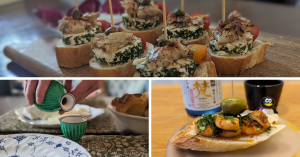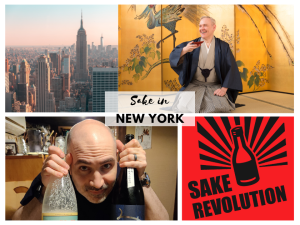I have already written about Hyakujuro Junmai Daiginjo Black Face (Kurojura or 黒面) here when I first tried it in Paris last year. This time my usual sake drinking partner, to whom I usually refer as just “a friend”, bought it from Tengu Sake just before Christmas and offered it for our regular sake session.
| Sake Type | Junmai Daiginjo |
| Brewery | Hayashi Honten |
| Prefecture | Gifu |
| Polishing Ratio | 50% |
| Acidity | 1.7 |
| SVM | +3 |
| ABV | 15.5% |
Hayashi Honten: young and innovative brewery

Hayashi Honten is a relatively young brewery located in Gifu Prefecture and was founded just in 1920. In a way, it’s still a startup in sake brewing terms :-). However, its young age makes it more willing to innovate still keeping the traditions.
Another interesting point about Hayashi Honten is that it’s one of the few breweries headed by a woman. Rieko Hayashi is the 5th generation scion of the Hayashi family.
Eiichi and Hyakujuro
The brewery has two ranges of sake: Hyakujuro (百十郎) and Eiichi (榮一). Hyakujuru is the largest range of Hayashi Honten’s sake. It includes 16 regular sake and 7 special editions. As I have already written before, the brand is named after a famous kabuki actor, Ichikawa Hyakujuro who lived at the end of the 19th beginning of the 20th centuries.

The actor is famous for sending 1,200 cherry trees to be planted along Shinsakae River which flows through his native Kakamigahara City. This area is now one of the top spots to admire cherry blossom in Japan.
The second line of sake, Eiichi, is named after the brewery’s founder, Hayashi Eiichi. There are only two sake in this line, Junmai Daiginjo and Junmai. Hayashi Honten also makes a number of other special sake including superb Golden Amber, an aged sake.
How was Hyakujuro Junmai Daiginjo?

So what I can say about Black Face. It’s a sweeter sake but very balanced. The nose is very fruity. I could smell sweet apples and strawberries, but also wood, stone and a bit of vanilla. When you start drinking it, you feel straight away that the sake is full of umami. It has dried fruit and some honey in the taste, which goes very well with heartier food.
We had Hyakujuro KuroJura with hard cheese as a starter and miso-marinated salmon as a main dish. It was a very good match for the sake’s profile rich in umami and balanced acidity.

Overall, I enjoyed drinking Hyakujuro for the second time. However, I have to admit that I liked it more when I had it back in Paris last year. Probably it would be still better with slightly richer ginger pork I had then. Or maybe my palate has changed since then. Or Paris air complements the sake in its own special way.
In any way, it’s a very good sake and I would recommend it if the food pairing is right. So if this post piqued your interest, go and buy a bottle of Hyakujuro Junmai Daiginjo, make a nice hearty dish and enjoy it! Add if you like the post and want to read more, please consider subscribing!
Kampai!




